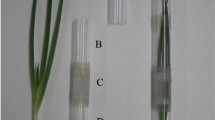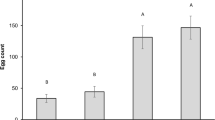Abstract
Factors contributing to host plant resistance in sorghum to Chilo partellus (Swinhoe) were studied. Oviposition on the plants in the field started 3 weeks after germination and peaked 2–6 weeks later. Egg batches (96.1%) were laid on the leaf blades compared with 3.9% on the leaf sheaths. On the leaf blades, significantly more egg batches were laid on the upper (57.2%) than on the lower leaf surfaces. In young plants, leaves attached to the upper and lower segments were preferred for oviposition, while leaves in the upper segments more or less maintained their share of egg batches over time; there was a shift from the leaves in the lower to those in the middle segments with the plant age. Differences among sorghum lines for oviposition were significant and these lines were divided into three categories based on their levels of oviposition.
Sorghum plants reacted to insect feeding in the stem by production of a red staining compound which did not significantly affect the development of the insect. Four damage symptoms were observed and these were related to different plant ages. Plants compensated damage by the production of extra tillers, some of which produced panicles that were ready by approximately the time of harvest. Plants infested 2 weeks after germination produced maximum tillers and juvenile panicles; and also had the least effective tillers, plant heights and grain yields. Grain yields were depressed in the infested plants for the cultivars tested, except in LC 119/80-3 where there were actual grain yield gains.
Leaf-feeding and ‘dead heart’ scores, which were related to reduced plant heights and yields in some of the cultivars tested, are proposed as rational indices for susceptibility ratings and monitoring of crop losses.
Résumé
Les facteurs contribuant à la résistance du sorgho au Chilo partellus (Swinhoe) ont été étudiés. L’oviposition sur les plantes dans les champs a commencé 3 semaines après la germination et a atteint le maximum, 2–6 semaines plus tard. Groupements d’oeufs (96,1%) étaient déposés sur les pousses des feuilles par comparaison a 3,9% déposés sur les enveloppes des feuilles. Il y avait plus d’oeufs en proportion significative (57,2%) déposés sur la partie supérieure que sur les surfaces inférieures des feuilles. Chez les jeunes plantes, les feuilles attachées aux segments supérieurs et inférieurs étaient choisis pour l’oviposition taudis que les feuilles sur les segments supérieurs maintenaient plus ou moins leur part de groupement d’oeufs pendant un certain temps; il y avait un déplacement des oeufs des segments inferieurs vers les segment au milieu avec l’âge de la plante. Des différences dans les lignées de sorgho quant à l’oviposition étaient significatives et ces lignées étaient divisées en trois catégories basées sur leur niveau d’oviposition. Les insectes furent nourris au tronc de plantes de sorgho. Les plantes réagirent en produisant un composé rouge qui n’a pas affecte le développement de l’insecte de facon significative. Quatre dégâts symptomatiques ont été observés et ils se rapportaient aux differents âges de plantes. Les plantes compensèrent les dégâts par la production des rejet supplémentaires dont certains produisaient des panicules qui étaient prêts vers le moment de la recolte. Les plantes infestées 2 semaines après la germinations produisirent un nombre maximum de rejets et de panicules juveniles; et avaient aussi les rejets des moins effectifs ainsi que des plantes réduites et des petites récoltes de graines. Les récoltes de graines étaient réduites dans les plantes infestées pour tous les cultivars testés excepté dans LC 119/80-3 ou il y avait un accroissement de la récolte. La destruction des feuilles par les insectes et les tiges forées qui se rapportait aux hauteurs réduites des plantes et des récoltes dans certain cultivars testés étaient proposés comme indices rationnels de susceptibilité et de contrôle de pertes de récoltes.
Similar content being viewed by others
References
Alghali A. M. (1984a) Studies on the biology, damage and crop loss assessment of sorghum midge Contarinia sorghicola coq. (Diptera: Cecidomyiidae). Insect Sci. Applic. 5, 253–258.
Alghali A. M. (1984b) Mating and ovipositional behaviour of the stalkeyed fly, Diopsis thoracica West (Diptera: Diopsidae) on rice. Entomologia exp. appl. 36, 151–157.
Alghali A. M. and Osisanya E. O. (1982) Oviposition by Diopsis macrophthalma Dalma (Diptera: Diopsidae) on different rice varieties and development of ‘dead hearts’. Bull. ent. Res. 72, 583–588.
Alghali A. M. and Osisanya E. O. (1984) Effect of damage by stalk-eyed fly, Diopsis thoracica West Diptera: Diopsidae) on the yield components of the rice crop. Expl Agric. 20, 225–234.
Alvarado-Rodriguez B., Leigh T. F. and Lange W. H. (1982) Oviposition site preference by the tomato fruitworm (Lepidoptera: Nuctuidae) on tomato, with notes on plant phenology. J. econ. Ent. 75, 895–898.
Dabrowski Z. T. and Kidiavai E. L. (1983) Resistance of some sorghum lines to the spotted stalk-borer, Chilo partellus under Western Kenya conditions. Insect Sci. Applic. 4, 119–126.
Harris K. M. (1962) Lepidopterous-stem borers of cereals in Nigeria. Bull. ent. Res. 53, 139–171.
Ingram W. R. (1958) Stalk borers associated with Gramineae in Uganda. Bull. ent. Res. 49, 367–383.
Jotwani M. G. and Young W. R. (1972) Recent developments on chemical control- of insect pests of sorghum. In Sorghum in the Seventies (Edited by Rao N. G. P. and House L. R.) pp. 377–398. Oxford and IBH Publishing, New Delhi, India.
Pathak R. S. and Olela J. C. (1983) Genetics of host plant resistance in food crops with special reference to sorghum stem-borers. Insect Sci. Applic. 4, 127–134.
Roome R. E. and Padgham E. E. (1976) COPR/ICRISAT Collaborative Project on Sorghum Stem Borer Ecology and Behaviour—report on first field study period. July-November, 1976.
Seshu Reddy K. V. (1981) Pest management in sorghum — II. In Sorghum in the Eighties, pp. 237–246, Proceedings of International Symposium on Sorghum, 2-7th Nov. 1981. ICRISAT, India.
Seshu Reddy K. V. (1983) Studies on the stem-borer complex of sorghum in Kenya. Insect Sci. Applic. 4, 3–10.
Seshu Reddy K. V. and Davies J. C. (1978) A new medium for mass rearing of the sorghum stem-borer, Chilo partellus Swinhoe (Lepidoptera: Pyralidae) and jts use in resistance screening. Ind. J. PL Prot. VI, 48–55.
Teetes G. L. (1980) Breeding sorghum resistant to insects. In Breeding Plants Resistant to Insects (Edited by Maxwell F. G. and Jennings P. R.), pp. 457–485. A Wiley-Interscience Publication Handbook. ICRISAT Information Bulletin No. 12.
Trehan K. N. and Butani D. K. (1949) Notes on the life history, bionomics and control of Chilo zonellus Swinhoe in Bombay province. Ind. J. Ent. 11, 47–59.
Van Hamburg H. (1980) The grain sorghum stalk borer Chilo partellus (Lepidoptera: Pyralidae): Survival and location of larvae at different infestation levels in plants of different ages. J. ent. Soc. sth. Afr. 43, 71–76.
Young W. R. and Teetes G. L. (1977) Sorghum entomology. A. Rev. Ent. 22, 193–218.
Author information
Authors and Affiliations
Rights and permissions
About this article
Cite this article
Alghali, A.M. Insect-Host Plant Relationships. Int J Trop Insect Sci 6, 315–322 (1985). https://doi.org/10.1017/S1742758400004574
Received:
Revised:
Published:
Issue Date:
DOI: https://doi.org/10.1017/S1742758400004574




